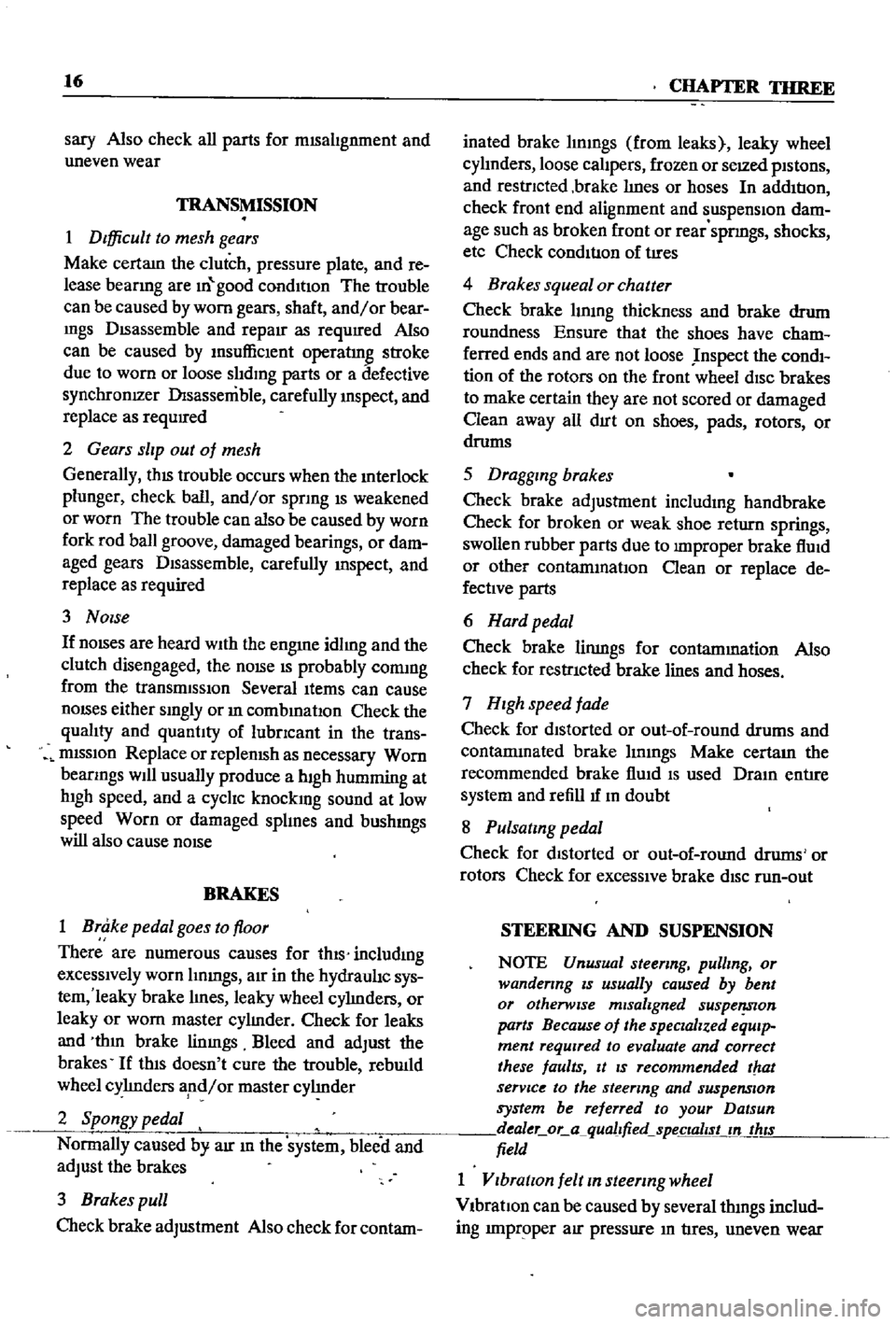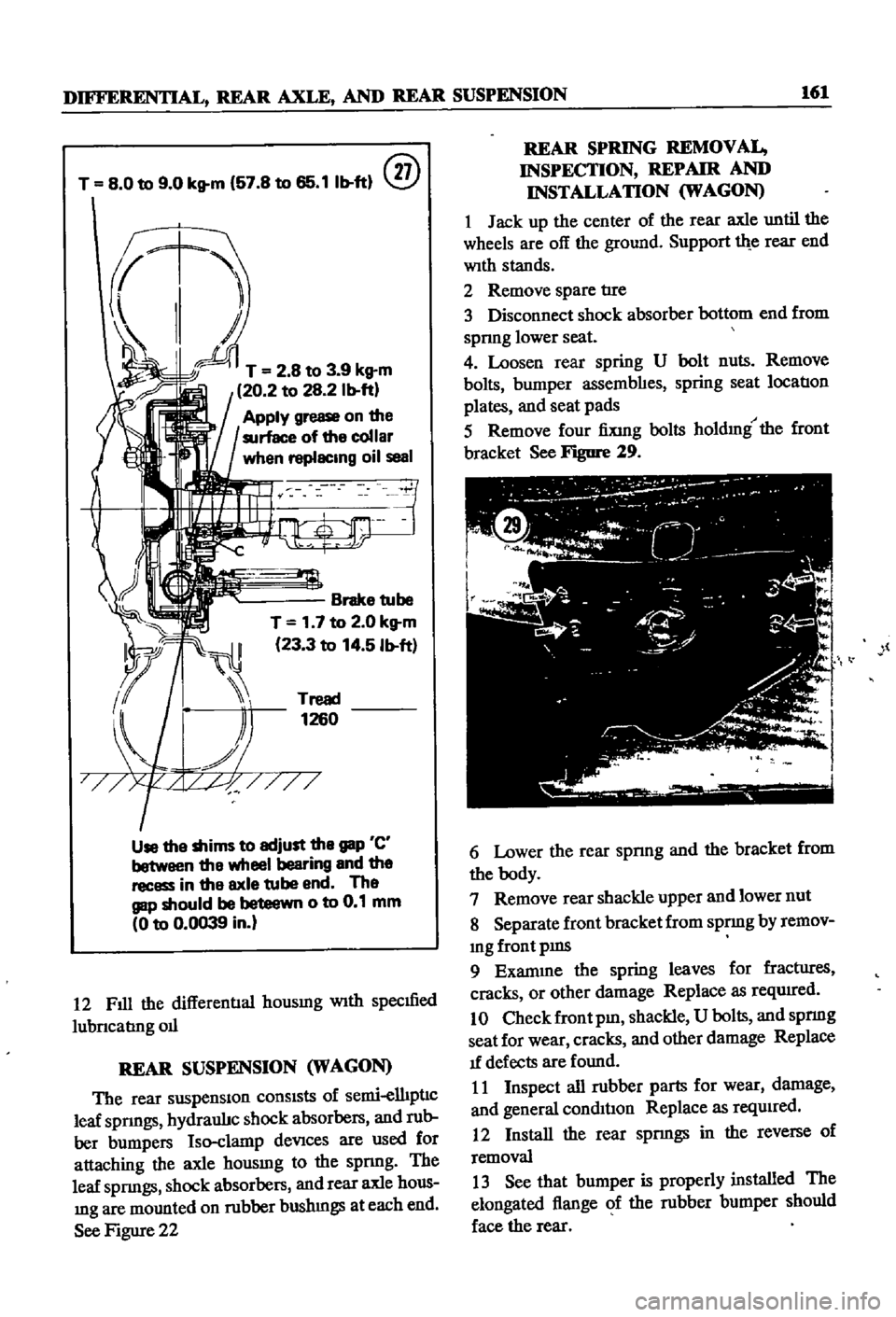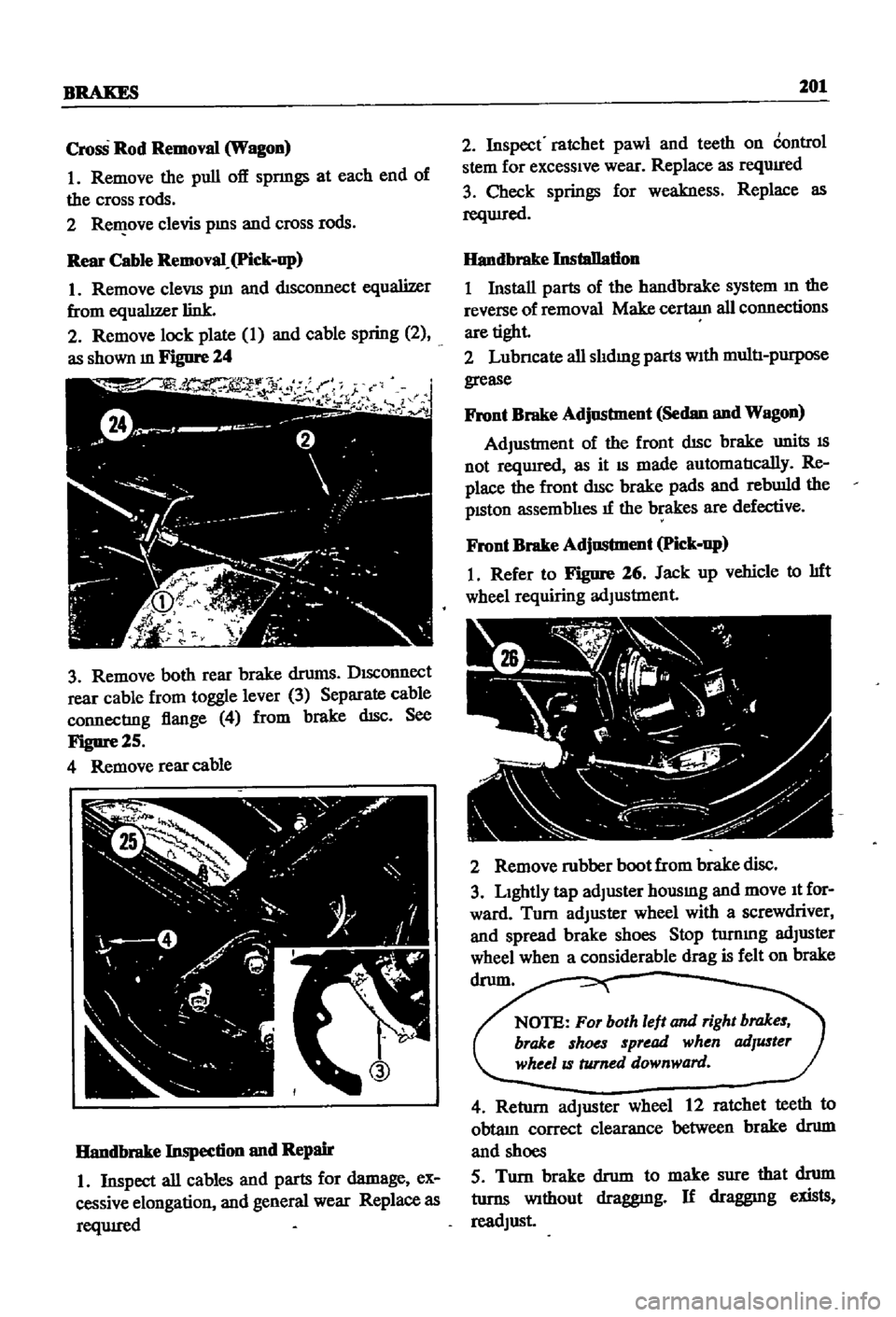1968 DATSUN 510 brake pads
[x] Cancel search: brake padsPage 21 of 252

16
CHAPTER
TIlREE
sary
Also
check
all
parts
for
mlSaltgnment
and
uneven
wear
TRANSMISSION
1
Difficult
to
mesh
gears
Make
certam
the
clutch
pressure
plate
and
re
lease
beanng
are
m
good
condItion
The
trouble
can
be
caused
by
worn
gears
shaft
and
or
bear
mgs
DISassemble
and
repaIr
as
requIred
Also
can
be
caused
by
msufficlent
operatmg
stroke
due
to
worn
or
loose
sltdmg
parts
or
a
defective
synchronIZer
DIsassemble
carefully
InSpect
and
replace
as
requIred
2
Gears
slip
out
of
mesh
Generally
thIS
trouble
occurs
when
the
mterlock
plunger
check
ball
and
or
spnng
IS
weakened
or
worn
The
trouble
can
also
be
caused
by
worn
fork
rod
ball
groove
damaged
bearings
or
dam
aged
gears
DIsassemble
carefully
mspect
and
replace
as
required
3
NOIse
If
nOISes
are
heard
wIth
the
engme
idlmg
and
the
clutch
disengaged
the
nOIse
IS
probably
conung
from
the
transmISSIOn
Several
Items
can
cause
nOISes
either
smgly
or
m
combmatIon
Check
the
qualIty
and
quantity
of
lubrIcant
in
the
trans
mISSIon
Replace
or
replenISh
as
necessary
Worn
bearIngs
wIll
usually
produce
a
lugh
humming
at
hIgh
speed
and
a
cycltc
knockIng
sound
at
low
speed
Worn
or
damaged
splInes
and
bushmgs
will
also
cause
nOIse
BRAKES
1
Brake
pedal
goes
to
floor
There
are
numerous
causes
for
thIS
includIng
excessIvely
worn
Itnmgs
aIr
in
the
hydraultc
sys
tem
leaky
brake
lmes
leaky
wheel
cylmders
or
leaky
or
worn
master
cylmder
Check
for
leaks
and
thIn
brake
linmgs
Bleed
and
adjust
the
brakes
If
thIS
doesn
t
cure
the
trouble
rebwld
wheel
cylmders
a
nd
or
master
cylmder
2
Spongy
pedal
Normally
caused
by
aIr
m
the
system
blee
d
and
adjust
the
brakes
3
Brakes
pull
Check
brake
adjustment
Also
check
for
contam
inated
brake
Itmngs
from
leaks
leaky
wheel
cyltnders
loose
caltpers
frozen
or
seIZed
pIstons
and
restrIcted
brake
lmes
or
hoses
In
addItion
check
front
end
alignment
and
suspensIOn
dam
age
such
as
broken
front
or
rear
sprmgs
shocks
etc
Check
condItIon
of
tIres
4
Brakes
squeal
or
chatter
Check
brake
lmmg
thickness
and
brake
drum
roundness
Ensure
that
the
shoes
have
cham
ferred
ends
and
are
not
loose
Inspect
the
condI
tion
of
the
rotors
on
the
front
wheel
dISC
brakes
to
make
certain
they
are
not
scored
or
damaged
Clean
away
all
dIrt
on
shoes
pads
rotors
or
drums
5
Draggmg
brakes
Check
brake
adjustment
includmg
handbrake
Check
for
broken
or
weak
shoe
return
springs
swollen
rubber
parts
due
to
unproper
brake
flUId
or
other
contammatIon
Clean
or
replace
de
fectIve
parts
6
Hard
pedal
Check
brake
linmgs
for
contammation
Also
check
for
restrIcted
brake
lines
and
hoses
7
High
speed
fade
Check
for
dIstorted
or
out
of
round
drums
and
contamInated
brake
lmmgs
Make
certam
the
recommended
brake
flUId
IS
used
Dram
entIre
system
and
refill
If
In
doubt
8
Pulsatmg
pedal
Check
for
dIStorted
or
out
of
round
drums
or
rotors
Check
for
excessIVe
brake
dISC
run
out
STEERING
AND
SUSPENSION
NOTE
Unusual
steermg
pullmg
or
wandermg
IS
usually
caused
by
bent
or
otherwise
mIsaligned
suspenszon
parts
Because
of
the
speCialized
equIp
ment
reqUired
to
evaluate
and
correct
these
faults
It
IS
recommended
t
tat
servIce
to
the
steermg
and
suspension
system
be
referred
to
your
Datsun
dealer
oca
quallfied
specrallst
m
thiS
field
1
VibratIOn
felt
m
steermg
wheel
VIbratIon
can
be
caused
by
several
thmgs
includ
ing
lll1proper
aIr
pressure
m
tIres
uneven
wear
Page 166 of 252

DIFFERENTIAL
REAR
AXLE
AND
REAR
SUSPENSION
161
T
8
0
to
9
0
kg
m
57
8
to
65
11b
ft
@
T
2
8
to
3
9
kg
m
20
2
to
28
2
Ib
ft
Apply
grease
on
the
surface
of
the
collar
when
replacing
oil
seal
Brake
tube
T
1
7
to
2
0
kg
m
23
3
to
14
5
Ib
ft
Tread
1260
Use
the
shims
to
adjust
the
gap
C
between
the
wheel
bearing
and
the
recess
in
the
axle
tube
end
The
gap
should
be
beteewn
0
to
0
1
mm
0
to
0
0039
in
12
Fill
the
differentIal
housmg
With
specmed
lubncabng
011
REAR
SUSPENSION
WAGON
The
rear
suspensiOn
consists
of
semi
elhpnc
leaf
spnngs
hydraulJc
shock
absorbers
and
rub
ber
bumpers
Iso
clamp
deVices
are
used
for
attaching
the
axle
housmg
to
the
spnng
The
leaf
spnngs
shock
absorbers
and
rear
axle
hous
mg
are
mounted
on
rubber
bushmgs
at
each
end
See
Figure
22
REAR
SPRING
REMOVAL
INSPECTION
REPAIR
AND
INSTALLATION
WAGON
1
Jack
up
the
center
of
the
rear
axle
until
the
wheels
are
off
the
ground
Support
th
e
rear
end
With
stands
2
Remove
spare
tIre
3
Disconnect
shock
absorber
bottom
end
from
spnng
lower
seat
4
Loosen
rear
spring
U
bolt
nuts
Remove
bolts
bumper
assembhes
spring
seat
location
plates
and
seat
pads
5
Remove
four
fiXing
bolts
holdmg
the
front
bracket
See
Figure
29
l
6
Lower
the
rear
spnng
and
the
bracket
from
the
body
7
Remove
rear
shackle
upper
and
lower
nut
8
Separate
front
bracket
from
spnng
by
remov
mg
front
pms
9
Exanune
the
spring
leaves
for
fractIires
cracks
or
other
damage
Replace
as
reqwred
10
Check
front
pm
shackle
U
bolts
and
spnng
seat
for
wear
cracks
and
other
damage
Replace
1f
defects
are
found
11
Inspect
all
rubber
parts
for
wear
damage
and
general
condil1on
Replace
as
reqUired
12
Install
the
rear
spnngs
in
the
reverse
of
removal
13
See
that
bumper
is
properly
installed
The
elongated
flange
of
the
rubber
bumper
should
face
the
rear
Page 195 of 252

190
CHAPTER
FOURTEEN
Master
Cylinder
Assembly
and
Installation
I
Assemble
the
master
cyhnder
m
the
reverse
order
of
dIsassembly
2
Pnor
to
assembly
soak
piston
cap
m
brake
flwd
Install
piston
so
that
It
seats
firmly
on
the
piston
cup
3
Coat
the
cyhnder
bore
and
pISton
assemblies
With
clean
brake
flwd
before
assembly
4
When
assembly
IS
complete
mount
master
cylmder
on
dash
wall
and
hook
connecting
rod
to
brake
pedal
Replace
return
sprmg
Fill
the
reservOir
With
clean
brake
flUid
5
If
aIr
has
seeped
mto
the
brake
Imes
bleed
the
brakes
as
descnbed
later
m
thIS
chapter
FRONT
DISC
BRAKES
SEDAN
AND
WAGON
Brake
Pad
Replacement
Pad
wear
should
be
checked
every
4
000
nuIes
Clearance
between
the
pad
and
the
rotor
IS
adjusted
automatIcally
and
therefore
IS
not
a
wear
mdlcator
Pad
thiCknesS
IS
checked
by
re
movmg
the
antI
rattle
clJp
When
the
pad
hning
becomes
worn
to
0
04
Imm
replace
all
pads
on
the
front
wheels
I
Remove
the
hub
cap
loosen
the
hub
nuts
jack
up
the
vehicle
support
with
stands
and
remove
the
front
wheels
2
Remove
the
antI
rattle
clJp
from
the
caliper
plate
as
shown
m
Figure
S
jty
3
Loosen
the
bleed
screw
Pull
the
calJper
plate
outward
4
Push
the
pISton
m
approximately
0
157
in
4mm
as
shown
m
Figure
6
5
The
outer
plate
should
be
loose
enough
to
be
removed
See
Figure
7
6
Dra
y
the
calJper
plate
rlfward
and
remove
the
inner
pad
7
Wipe
exposed
surface
of
piston
thoroughly
8
Push
the
piston
mto
the
cyhnder
bore
untJI
the
new
pads
can
be
mstalled
onto
the
calJper
plate
9
After
instl
llatIon
test
the
brakes
at
slow
speed
to
make
certam
they
are
fitted
properly
and
that
no
au
entered
the
hydraul1c
hnes
Bleed
the
brake
system
If
required
Front
Disc
Brake
Removal
I
Jack
up
the
vehicle
place
It
on
stands
and
remove
the
wheels
P
Page 196 of 252

BRAKES
191
2
Disconnect
the
front
brake
hose
from
the
brake
tube
See
Figure
8
and
plug
the
brake
hne
to
avoid
flwd
loss
3
Screw
out
the
bolts
fixing
the
calJper
to
the
knuckle
flange
and
remove
the
calJper
assembly
as
shown
m
Figure
9
4
Remove
the
spmdle
nut
and
the
dISC
hub
Separate
the
rotor
from
the
hub
assembly
See
Figure
10
Front
Disc
Brake
Disassembly
Figure
11
next
page
IS
an
exploded
diagram
of
the
front
disc
brake
assembly
Refer
to
figure
and
follow
the
followmg
procedures
I
Remove
the
antI
rattle
clip
from
the
calJper
plate
and
remove
the
brake
pads
4
2
Remove
the
tension
spnngs
and
pull
the
cyhnder
out
of
the
caliper
plate
3
Remove
the
piston
by
applymg
air
or
hy
draulJc
pressure
to
the
flwd
mlet
hole
Remove
the
rubber
seal
from
the
groove
on
the
cyhnder
Remove
the
retamer
and
Wiper
seal
The
pISton
can
now
be
removed
Front
Disc
Brake
Inspection
and
Repair
I
Check
the
cyhnder
assembly
for
leakage
and
damage
Replace
If
defects
or
damage
are
apparent
2
Check
the
disc
brake
pads
for
wear
and
cracks
Replace
all
pads
If
It
IS
necessary
to
replace
any
fi
3
Check
the
caliper
for
damage
Replace
as
reqUIred
4
Check
the
rotor
for
scratches
sconng
and
general
conditIon
The
rotor
can
be
resurfaced
If
defects
are
found
Standard
rotor
thiCknesS
IS
o
0394
m
IOmm
The
hm1t
of
reconditIOning
thickness
IS
0
331
m
8
4mm
Replace
rotors
If
recondltIomng
limits
have
been
reached
5
Check
the
rotor
for
TWlout
usmg
a
dial
gauge
as
shown
m
Figure
12
Rnnout
ot
the
rotor
should
be
less
than
0
0024
m
0
06DlIll
Page 206 of 252

BRAKES
ZOI
Cross
Rod
Removal
Wagon
I
Remove
the
pull
off
spnngs
at
each
end
of
the
cross
rods
2
RelI
ove
clevis
pms
and
cross
rods
Rear
Cable
Removal
Pick
op
1
Remove
cleVIS
pm
and
disconnect
equalizer
from
equal1zer
link
2
Remove
lock
plate
1
and
cable
spring
2
as
shown
ill
Figure
24
3
Remove
both
rear
brake
drums
DISConnect
rear
cable
from
toggle
lever
3
Separate
cable
connecting
flange
4
from
brake
dIsc
See
Figure
25
4
Remove
rear
cable
Handbrake
Inspection
and
Repair
1
Inspect
all
cables
and
parts
for
damage
ex
cessive
elongation
and
general
wear
Replace
as
reqUlred
I
2
Inspect
ratchet
pawl
and
teeth
on
control
stem
for
excessive
wear
Replace
as
reqUIred
3
Check
springs
for
weakness
Replace
as
reqUIred
Handbrake
Installation
I
Install
parts
of
the
handbrake
system
m
the
reverse
of
removal
Make
certam
all
connections
are
tight
2
Lubncate
all
slIdmg
parts
With
muItl
purpose
grease
Front
Brake
Adjustment
Sedan
and
Wagon
AdJustment
of
the
front
dIsc
brake
units
18
not
reqwred
as
it
18
made
automatIcally
Re
place
the
front
dISC
brake
pads
and
rebwld
the
pISton
assemblJes
If
the
brakes
are
defective
Front
Brake
Adjustment
Pick
up
I
Refer
to
Figure
26
Jack
up
vehicle
to
lIft
wheel
requiring
adJustment
2
Remove
rubber
boot
from
brake
disc
3
Lightly
tap
adJuster
housmg
and
move
It
for
ward
Turn
adJuster
wheel
with
a
screwdriver
and
spread
brake
shoes
Stop
turnmg
adJuster
wheel
when
a
considerable
drag
is
felt
on
brake
drum
NOTE
For
both
left
and
right
brakes
brake
shoes
spread
when
adJuster
wheelIS
turned
downward
4
Return
adJuster
wheel
12
ratchet
teeth
to
obtam
correct
clearance
between
brake
drum
and
shoes
5
Turn
brake
drum
to
make
sure
that
drum
turns
Without
draggmg
If
draggmg
exists
readJust